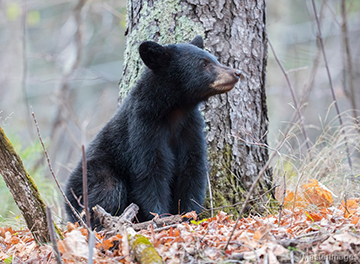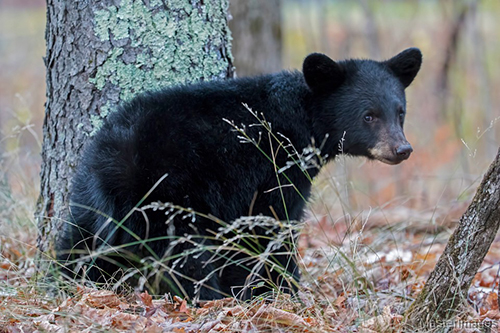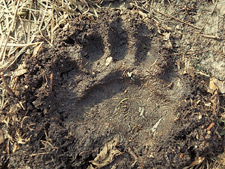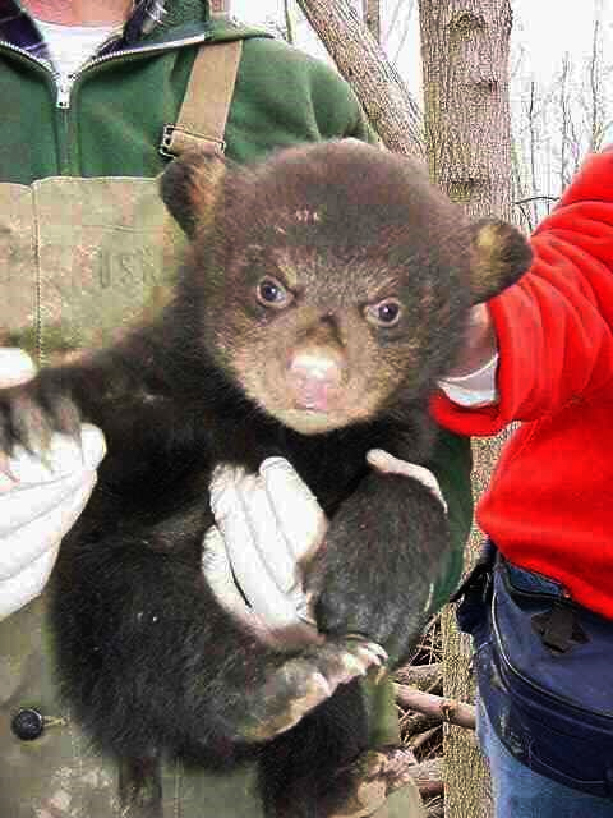
Attention Winter Adventurers | The NYSDEC needs your help!
Friday, January 19, 2018
By: Lisa M. Genier - Adirondack Council Program Analyst
Wildlife biologists at the Department of Environmental Conservation (DEC) are asking for the public’s help in their ongoing monitoring of black bear dens during the winter season. Hikers, hunters and outdoorspeople can help by taking note of a bear den they may find and reporting it to their local DEC wildlife office and the app iSeeMamals to report signs of a bear. Take a photo and record GPS coordinates if possible.
 Black Bear
Black Bear
Photo by Larry Master
Black bears are an important and natural component of the Adirondack Park’s ecosystem. Monitoring new and established bear dens allows biologists opportunities to fit bears with radio collars, and track the bears’ activities throughout the year. Additionally, keeping track of the dens helps biologists monitor cub production, condition and survival.
Bear dens may be found in all sorts of locations - in tree cavities, rock crevices or under heavy brush and fallen trees. Generally, bears give birth to their cubs in January or early February, so if you’re lucky
enough to be near a den during this time you may hear the cubs’ high pitched squeals!
The DEC cautions all who find themselves near a bear den to not approach or disturb it, just record the location and move away from the site - for your safety and the safety of the bears.
From the DEC, "Bears may den in a rock crevice, tree cavity, or under heavy bush or fallen trees. Female bears generally give birth in January or early February, and if you are near a den you may hear the cubs' high-pitched squeals. New York hikers and hunters cover countless miles of wooded terrain each year. DEC urges anyone who finds a bear den not to approach or disturb the den, but simply to note the location and move away from the den site."
Did You Know?
- Black bears are the second largest mammal in New York State. (The moose is the largest.)
- Bears are excellent climbers and can run at speeds of 25 mph.
- Although bears remain dormant for up to five months in the winter, they are not considered "true hibernators" since they can wake up if disturbed.
- Black bears are typically solitary animals traveling alone except when females have cubs. Typically, a female will have two to three cubs born in the winter while the female is in the den. Cubs stay with the adult female for over a year and then disperse as yearlings on their own.
 Black Bear
Black Bear
Photo by Larry MasterBlack Bear Facts:
Size: Bears are 4 ½ - 5 feet long and 2-3 feet high on all four paws at the shoulder. Standing on its hind
feet a black bear can be 5-7 feet tall. A female weighs 150-250 lbs; males weigh 200-600 lbs.
Scat: Bear droppings may be over an inch thick, and tubular. A pile of bear scat may be very large. The scat varies with diet and food availability based on the season. In the springtime, scat contains mostly vegetation. In summertime, scat contains mostly berries, while in fall scats have more nuts and acorns and sometimes corn or apples.
Tracks: Look for five toes, claw marks and a large heel pad. The hind tracks are longer and may reach 7 inches long by 5 inches wide. The front tracks are smaller, but often reach 5 inches long by 5 inches wide.
|
|
|
Other Signs to Look for:
Claw marks or scars on trees and bark torn or ripped off. They are usually made to mark the tree or because they are climbing the tree in search of food.
Have you ever seen a bear in the wild? Share your story below.
Would you like to comment on what you've read or viewed? We'd love to hear from you. Please click to send us a message.
 Lisa M. Genier joined the Council in 1992 working as its Legislative Associate in the Albany office. During her tenure, she played a role in the creation of the Environmental Protection Fund, which has been used to fund land purchases and environmental programs in the Adirondack Park and around the state. She was also a member of the negotiating teams that worked on re-licensing agreements for several hydroelectric facilities in the Park, which preserved thousands of acres of land, expanded recreational opportunities, and protected other natural resources. Lisa now works part-time as Program Analyst writing action alerts, interacting with members, managing the Council’s website, and serving in a consultative role on legislative and other issues.
Lisa M. Genier joined the Council in 1992 working as its Legislative Associate in the Albany office. During her tenure, she played a role in the creation of the Environmental Protection Fund, which has been used to fund land purchases and environmental programs in the Adirondack Park and around the state. She was also a member of the negotiating teams that worked on re-licensing agreements for several hydroelectric facilities in the Park, which preserved thousands of acres of land, expanded recreational opportunities, and protected other natural resources. Lisa now works part-time as Program Analyst writing action alerts, interacting with members, managing the Council’s website, and serving in a consultative role on legislative and other issues.






